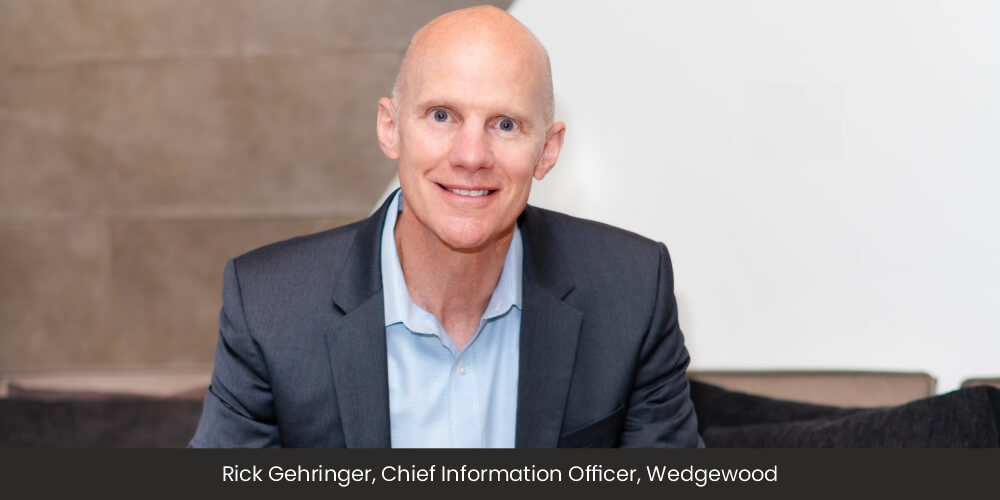As organizations accelerate their growth goals while establishing new ways of working in 2022 and beyond, CIOs’ activities will deeply impact people and processes throughout the company.
The spotlight is on CIOs to advise, persuade, and motivate enterprises to remain innovative, achieve productivity, and stay at the forefront of their industry. CIOs have an opportunity to synchronize core business and IT processes in order to develop a resilient organization in the face of continual technological advances.
Rick Gehringer, Chief Information Officer at Wedgewood, a senior technology executive, has extensive expertise in utilizing technology to fulfill the goals of commercial, non-profit, and government companies in both domestic and foreign settings. He is a dynamic team leader with a proven track record of transforming corporate strategy and opportunity into transformative technological solutions. He specializes in IPOs, mergers & acquisitions, post-deal integration, and technological startups.
Rick had approximately 40 years of successful business startup experience before joining Wedgewood. When Rick joined Wedgewood in 2020, the organization sought a seasoned, multi-faceted CIO to remove technological barriers and create new pathways to growth and innovation. Rick’s expertise in scaling past firms complemented the company’s desire for expansion. The chance to impact new business models, build strategic alliances, and enhance procedures piqued Rick’s interest, and he believed he would fit right into the adaptable and energetic environment/culture.
Wedgewood
Wedgewood was founded in 1985 with the goal of revitalizing communities through the acquisition, renovation, and resale of residential real estate using a sustainable design approach. Almost forty years later, it has grown from a single-family home firm to a multi-faceted organization with a footprint spanning over 20 states.The team believes in the value of a home, and its suite of complementing brands helps Wedgewood achieve its mission of delivering homeownership opportunities as well as great tenant experiences inside apartment building communities. Wedgewood is a privately-held company based in Los Angeles with operations in Las Vegas and Dallas.
Rick is the leader of technology innovations, decision support platforms, business systems, infrastructure, and cybersecurity at Wedgewood. He is a member of the executive team, where he works to make decisions that will ensure the company’s long-term success.
Setting IT Priorities
Rick sees the CIO’s position as a business leader in charge of technology. Similarly, COO business executives oversee operations, while CFO business leaders oversee finance and accounting. A CIO, like any successful business leader, must clearly understand their area (in this case, technology management) and be an effective communicator. Learning to translate technology into business terms is a skill, much like learning a foreign language. CIOs must hone this expertise. The other ingredient is curiosity. He says, “A naturally curious CIO will ask the right questions, seeking to translate the answers into transformational solutions.”
One of Rick’s top priorities when joining the company was to transition them from two settings; on-premise to fully cloud-based. His goal was to eliminate the risk and inefficiencies associated with two settings while capitalizing on the synergies provided by cloud products. Another objective is to position a technical team to collaborate with the company, give recommendations on where the technology may be most helpful, and avoid areas where technology wastes energy and money. Finally, he attempts to provide the company’s workers with the most intelligent and user-friendly technology that enables orchestration among peers.
Adopting Market Trends
Rick believes the overall simplification of basic technological functions is the most significant improvement he has witnessed in the last several years. Historically, it was commonplace to handle a large number of underlying technologies to progress to higher-order (and greater value) capabilities. Those core capabilities are now just a few clicks away, and they do not demand the care that earlier foundational technology required. The time-to-value has been dramatically decreased and will remain so for a long time. This category includes virtual machines, artificial intelligence services, curated data collections, and online security solutions. Using data analytics is undoubtedly the most significant breakthrough in recent years.
While technological improvements are at their pinnacle, Rick concentrates on discovering an internal company capacity that has the potential to be adopted in a reasonably-sized market. He believes in making such capacity available to the outside world while maintaining critical competitive practices. For years, technical investments have been directed inward; the assets developed as a result of this process may be of interest to others. He also adds, “Apply product marketing strategies to understand the opportunities, and choose the one with the most potential and palatable risk.”
Guiding Principles for Success
Before his professional career, Rick participated in competitive team sports—specifically, basketball and baseball in high school, rowing, and cycling in college- providing guiding principles that would later inspire his life professionally. For one, participating in team sports fostered a passion for collaboration and cooperation among teammates, resulting in outcomes that could not be achieved independently. Secondly, defining success, whether in sports or your career, is an opportunity for growth— to hone your craft and continue evolving. This passion for collaboration and development became a founding principle in defining success and his approach to his professional life.
Rick feels that the barometers of success are varied; some are highly tangible, and others are not. He mentions that “tangible metrics can be measured, compared, and reported; intangible metrics are important but more challenging to quantify.” He says intangibles deal with perceptions, sentiments, and value orders that are not always evident. He defines success as growth, improvement, and opportunity assessment by quantifiable metrics and intangible value measurements; ideally, both.
Rick says that being invited to speak at events at firms that do not compete with his job is the finest form of professional acknowledgment he has received. For a corporation to prioritize his insights over other uses of time and attention indicates to him that he has something valuable to give. Being asked to speak at conferences is another form of acknowledgment that drives Rick to keep sharing what he has learned during his career.
In the Near Future
Wedgewood has a substantial market share and is well-known for its real estate expertise. Not only has the company weathered challenges throughout multiple real estate market cycles, but they have also innovated and pursued new possibilities, all while remaining profitable. Few businesses can boast of such achievements. Rick anticipates that this method will continue to drive the company’s goals in the future years. He intends to continue his position in overseeing an essential aspect of how the organization will get there: using technology to its utmost and most suitable capabilities. He wants to be a part of a thriving firm that adds value to its owners and the communities it serves and is excited to have found such a home at Wedgewood.





